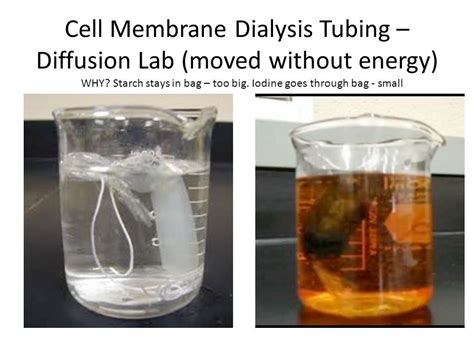Diffusion, the movement of molecules from an area of high concentration to an area of low concentration, is a fundamental process in living organisms. It plays a vital role in various physiological processes, including nutrient uptake, waste removal, and gas exchange.

Understanding Diffusion Across Membranes
Biological membranes, composed primarily of lipids and proteins, serve as barriers that regulate the passage of molecules. Diffusion across membranes occurs through two main mechanisms:
-
Passive Diffusion: The spontaneous movement of molecules down their concentration gradient without the need for energy input. Small, nonpolar molecules, such as oxygen and carbon dioxide, readily pass through membranes via passive diffusion.
-
Facilitated Diffusion: The transport of molecules with the aid of membrane-bound proteins called carrier proteins. These proteins bind to specific molecules and facilitate their movement across the membrane, often against a concentration gradient.
Investigating Diffusion Through Membrane Lab
Laboratory experiments play a crucial role in understanding the principles of diffusion through membranes. Here’s a step-by-step approach:
-
Prepare Semipermeable Membranes: Membranes of different compositions (e.g., dialysis tubing, cellophane) are used to separate two compartments.
-
Establish Concentration Gradients: Solutions with varying concentrations of a solute (e.g., glucose, potassium ions) are placed on either side of the membrane.
-
Monitor Solute Movement: The change in solute concentration over time is measured using methods such as spectrophotometry or conductivity measurements.
-
Analyze Data: The rate of diffusion is calculated by plotting the change in concentration against time and determining the slope of the linear portion of the graph.
Factors Affecting Diffusion Rate
The rate of diffusion is influenced by several factors, including:
-
Concentration Gradient: The greater the difference in concentration between the two compartments, the faster the rate of diffusion.
-
Temperature: Diffusion occurs more rapidly at higher temperatures due to increased molecular motion.
-
Surface Area and Thickness: Membranes with larger surface areas and thinner thickness facilitate faster diffusion.
-
Solute Size and Charge: Molecules with smaller sizes and neutral charges diffuse more easily through membranes.
Applications of Diffusion Through Membranes
The principles of diffusion through membranes have wide-ranging applications in biological and medical fields, such as:
-
Gas Exchange in Lungs: Oxygen and carbon dioxide are exchanged across the alveolar membranes during respiration.
-
Nutrient Absorption in Digestive Tract: Sugar and amino acids are absorbed from the small intestine into the bloodstream.
-
Kidney Function: Water, electrolytes, and waste products are filtered and reabsorbed through membranes in the kidneys.
-
Dialysis Treatment: Semipermeable membranes are used in hemodialysis and peritoneal dialysis to remove toxins from the blood.
Conclusion
Diffusion through membranes is a critical process that enables the exchange of substances essential for life. By understanding the principles and mechanisms of diffusion, scientists and researchers can develop innovative technologies and therapies to address healthcare challenges.
